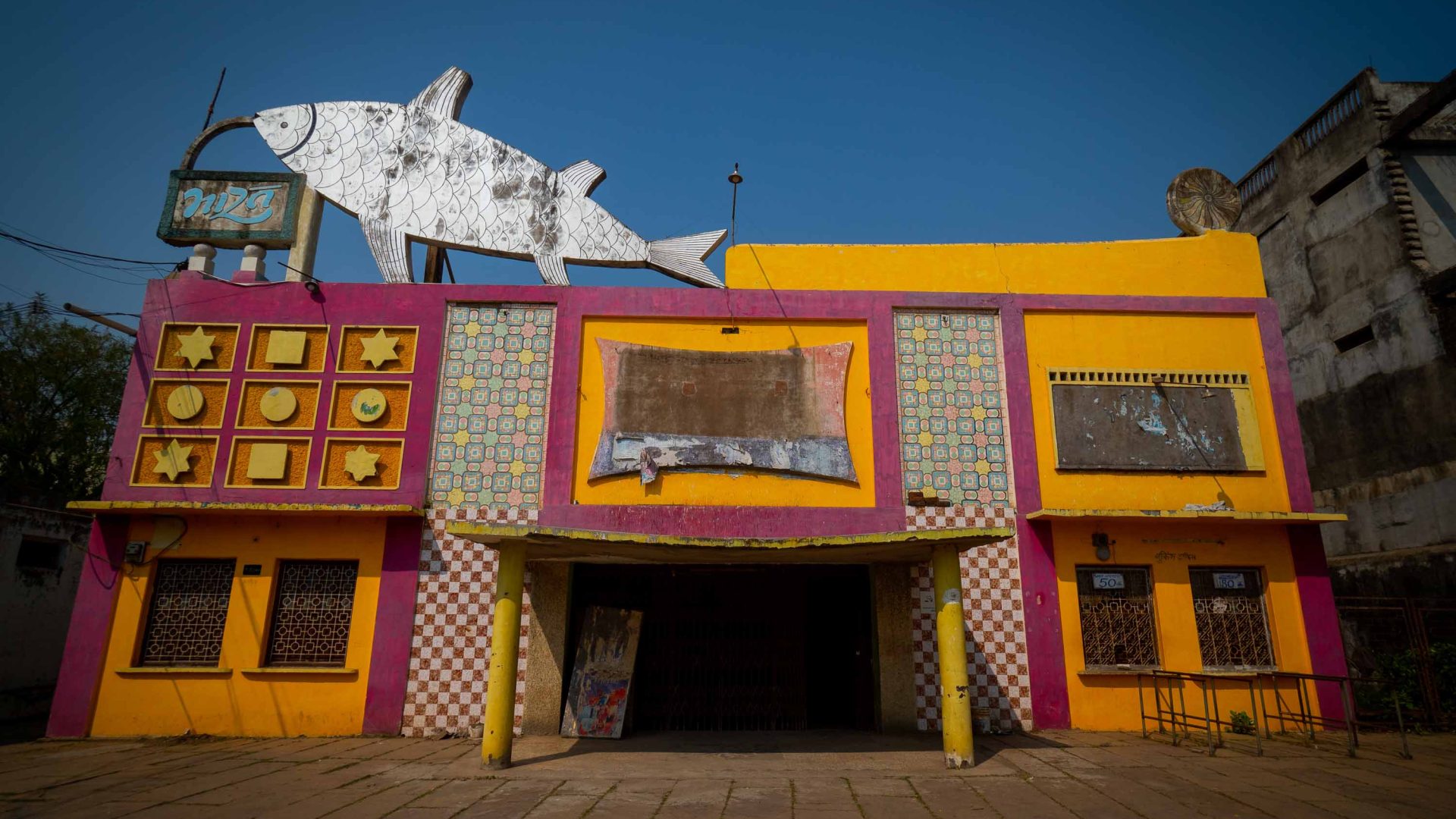
Photographer and cinematographer Hemant Chaturvedi has traveled 21,000 miles and through 800 towns to photograph India’s remaining single-screen cinemas before these architectural and cultural icons are lost completely to multiplexes and malls.


Photographer and cinematographer Hemant Chaturvedi has traveled 21,000 miles and through 800 towns to photograph India’s remaining single-screen cinemas before these architectural and cultural icons are lost completely to multiplexes and malls.
In early 2019, when photographer and erstwhile cinematographer Hemant Chaturvedi found himself at a loose end in his hometown of Allahabad in the northern Indian state of Uttar Pradesh, he jumped into an autorickshaw to shoot images at the old science block, “a beautiful building,” he says, of Allahabad University. On the way, he took a short detour to Lakshmi Talkies, an old cinema he remembered from his childhood. While Chaturvedi was expecting nostalgia, what he received was a shock. The late 1930s structure was locked and slated for demolition… to make way for a shiny shopping mall.
As with many significant discoveries in history, it was a serendipitous moment—the first time he saw a single-screen cinema with the idea of shooting it with his camera.
That was the birth of a monumental documentation project, although Chaturvedi did not know then how far this would take him. From then on, he says his quest was spurred on by what he describes as a “millennial term”—FOMO, or the fear of missing out.
Over the last four years, Chaturvedi, a former Bollywood cinematographer, has driven the length and breadth of India in his jeep—over 21,000 miles and through 800 towns—photographing single-screen cinemas across the country. With 90,000 photos (so far) from over 950 cinemas, he’s a man on a mission: To visually document these fading and crumbling icons of the past, before they are completely lost to us.
At 55, this Mumbai resident, who has worked on hundreds of ad films and 12 feature films, is far from being a millennial. But once he had seen and captured the magic of one such cinema, he was struck with a desire to see as many of them before they became mere footnotes in India’s cultural and architectural history.
“We have scant respect for our traditions, our history, and our architecture in India,” he rues, adding that everything now looks uniformly “glass-fronted” and how all towns have a cookie-cutter sameness.
“Like the vaudeville or Parsi theatre in Bombay, going to the cinema was an event or an experience—it was not just about the film you were going to watch.”
- Atul Kumar—Art Deco Trust Mumbai
With glorious names like Royal and Liberty and Minerva, many of India’s single-screen cinemas used to be urban landmarks, built in the early 1900s in prime locations. Chaturvedi explains that these cinemas reflected the ambitions of the owners, and their social and financial status at the time of construction.
Many of these cinemas display Art Deco architecture—one of the features that Chaturvedi has highlighted in his project—including uniquely Hindu symbols such as the lotus flower and the swastika. Architecture aficionados know that Mumbai has one of the largest collection of Art Deco buildings in the world, but that an international architectural trend had percolated down to obscure small towns across the country comes as a surprise.
In particular, Chaturvedi followed the work of prolific architect WM Namjoshi, who used Art Deco motifs to build some of the best cinemas of that time, from Jaipur’s Raj Mandir Theater to Mumbai’s iconic Maratha Mandir.
“Cinema was a new and modern form of entertainment in the early 20th century,” Atul Kumar, founder of the Art Deco Trust Mumbai tells me. “Like the vaudeville or Parsi theatre in Bombay, going to the cinema was an event or an experience—it was not just about the film you were going to watch.” He explains that the Art Deco style itself was modern and fresh at that time, allowing for “glamorous and opulent constructions.”
In parallel, the cinemas also reflected the changes in society itself, in a country poised for political independence and economic growth, and a time of significant change.
Sadly, most of these single-screen cinemas across India have shut down or have been in a state of disrepair for several years. The truth is they’re unable to compete against the glitzy allure of multiplexes with their caramel popcorns and fizzy colas, and the promise of a complete evening out for all the family.
Chaturvedi’s research has shown that in the first two decades of this century—even before the economic stress created by the pandemic—12,000 such cinemas were closed or demolished. Of the 200 once-bustling theatres in Mumbai, only 15 are still standing. New Delhi is even worse, with only three remaining—out of 80.
“Hemant Chaturvedi’s brilliant and selfless project is one of the most important photographic archives of single-screen cinemas in India. A near forgotten world has re-emerged through his photographs.”
- Nandini Ramnath, writer
With many of these structures erased from both public maps and memory, Chaturvedi often took help from local rickshaw drivers, as he first did in Allahabad, to seek out these abandoned edifices. He would also stop to chat with shopkeepers and street vendors around these cinemas, to tap into their storehouse of facts—generously mixed with gossip and speculation.
It was one such neighborhood vendor in Allahabad who told Chaturvedi about Niranjan Cinema, the first air-conditioned theatre in Chaturvedi’s home state of Uttar Pradesh. “When the show ended, there would be a crowd in front of the main doors,” he told him, “so that we could all enjoy the air conditioning when they opened. We couldn’t afford the ticket price, but we all wanted to feel the chill.”
Chaturvedi’s images bring these historic movie theaters alive with their attention to the minutiae—forgotten film rolls and torn posters, smudged wall murals, aging projectionists and ticket sellers. Then there are the ornate balustrades, geometric patterns on ticket windows, stucco work on ceilings and other classic Art Deco features.
These photos from far-flung towns like Bhusaval and Jhunjhunu and Madurai are a throwback to a time when the release of a new movie starring a favorite “superstar” was an occasion for exultant celebration, with crowds throwing coins at the screen and dancing to the ditties.
Nandini Ramnath, film writer and critic at the news website Scroll, tells me. “Hemant Chaturvedi’s brilliant and selfless project is one of the most important photographic archives of single-screen cinemas in India. A near-forgotten world has re-emerged through his photographs.”
She’s also aware of the economic challenges of maintaining these cinemas, as opposed to the economic benefits of multiplying revenues by running several films at one go. “Sadly, this world is difficult to run and maintain,” she says.
Then, there’s the problem of perception: A belief that multiplexes are cleaner and better in every way. “Single screens are associated with a bygone era, a past where all of us were somehow poorer and more willing to watch movies in compromised conditions,” she adds.
For Chaturvedi himself, this has been a self-funded passion project. However, he doesn’t believe there will be a miraculous interest in the revival of these iconic cinemas. At best, he hopes this will be collated into a book or film, to serve as a visual archive of single-screen cinemas for future generations.
For now, he says he has miles to go—literally—touching new corners of the country, as he continues to capture these forgotten landmarks on celluloid, remembering the past for the future.
***
Adventure.com strives to be a low-emissions publication, and we are working to reduce our carbon emissions where possible. Emissions generated by the movements of our staff and contributors are carbon offset through our parent company, Intrepid. You can visit our sustainability page and read our Contributor Impact Guidelines for more information. While we take our commitment to people and planet seriously, we acknowledge that we still have plenty of work to do, and we welcome all feedback and suggestions from our readers. You can contact us anytime at hello@adventure.com. Please allow up to one week for a response.

Charukesi Ramadurai is a freelance journalist currently living in Kuala Lumpur. Her work has been published in a number of international publications, including The Guardian, BBC Travel, South China Morning Post and National Geographic Traveller. She has a keen interest in wildlife and conservation issues, and in stories at the intersection of humans and the natural world.




Can't find what you're looking for? Try using these tags: